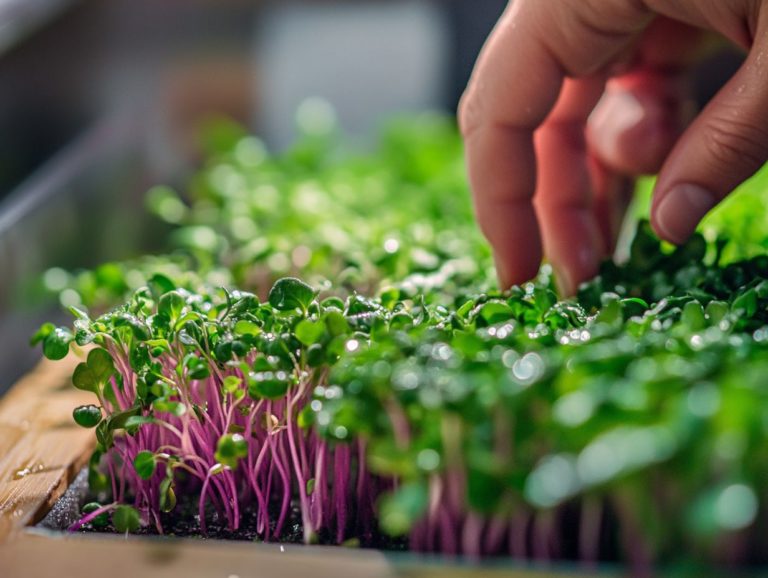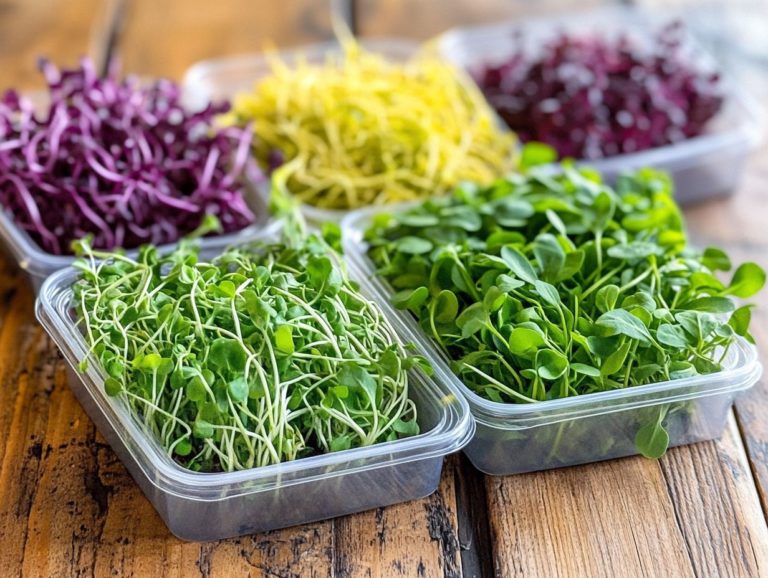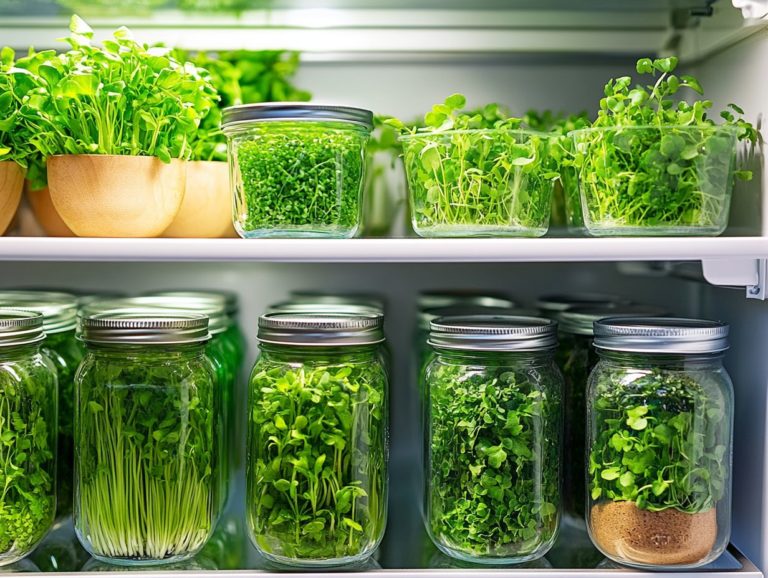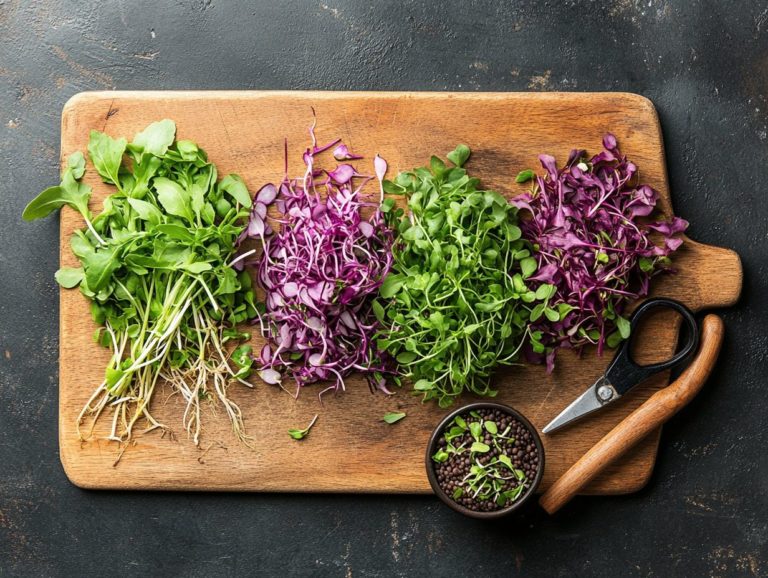5 Microgreens for Anti-Aging Benefits
Microgreens have taken the culinary scene by storm for good reason. They re not just eye-catching; their vibrant flavors and textures make them a must-have. Plus, they offer impressive health benefits that can elevate your meals.
In this article, you ll explore five nutrient-rich microgreens that can significantly enhance your anti-aging journey. From broccoli to sunflower, each option boasts unique properties that support your overall wellness.
You ll also learn what microgreens are, their nutritional advantages, and inventive ways to incorporate them into your daily meals. Get ready to uncover delectable recipes and essential growing tips that will boost both your kitchen and your health!
Contents
Key Takeaways:
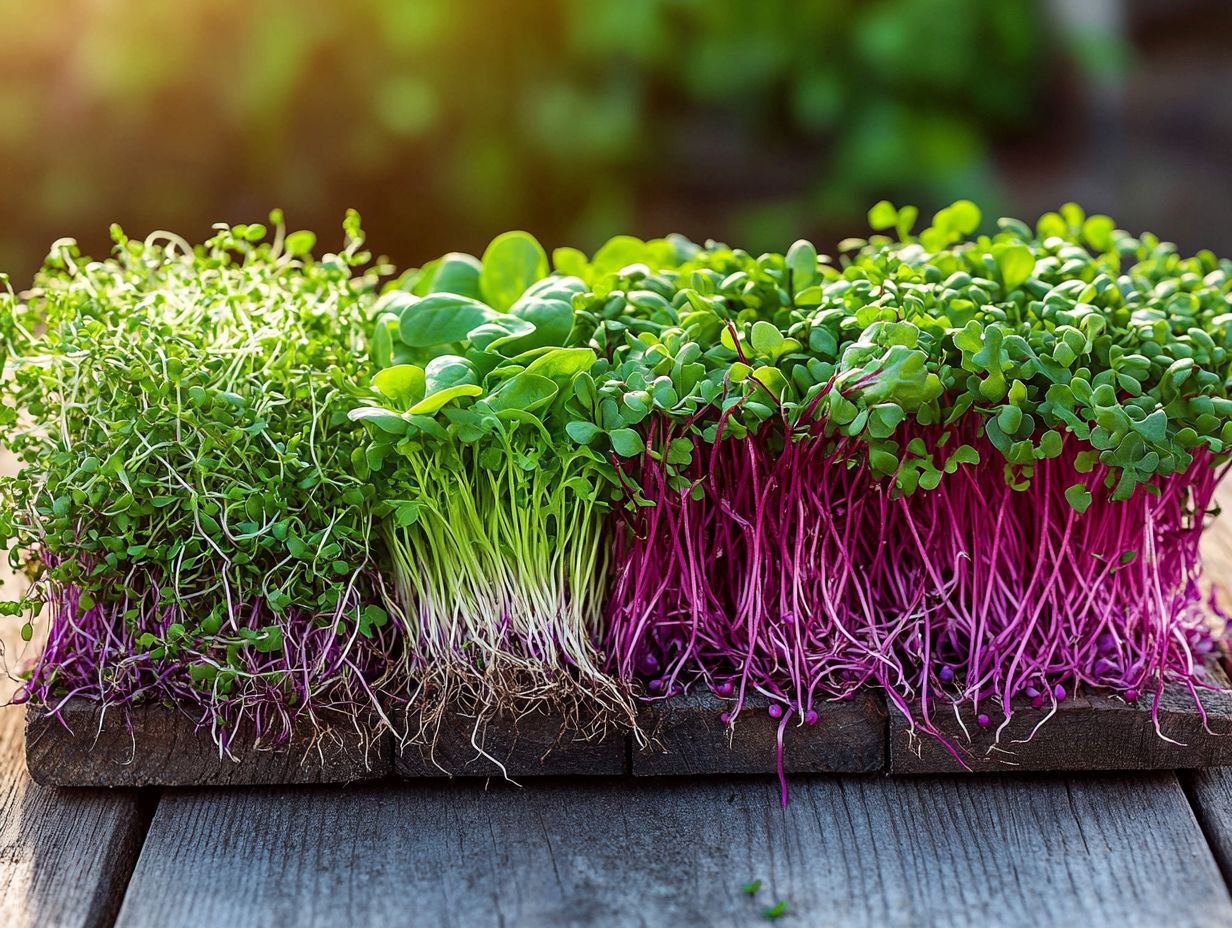
- Incorporate these 5 microgreens into your diet for anti-aging benefits: broccoli, red cabbage, pea shoot, sunflower, and radish.
- Microgreens are packed with nutrients that can enhance overall health and slow down the aging process.
- Add microgreens to your meals whether in salads, smoothies, or as a garnish to enjoy their anti-aging benefits.
1. Broccoli Microgreens
Broccoli microgreens are tiny powerhouses brimming with essential nutrients and potent phytochemicals, which are natural compounds found in plants that can enhance health. Recognized for their remarkable benefits, these microgreens are rich in antioxidants and sulforaphane a compound linked to cancer prevention and improved metabolic health as per research from the Cleveland Clinic.
They contain vitamins A, C, and K, each playing a crucial role in your well-being. Vitamin A supports vision and immune function. Vitamin C is a robust antioxidant, combating free radicals in your body. Vitamin K is essential for proper blood clotting and maintaining bone health.
Studies suggest that these nutrients may help reduce inflammation and enhance heart health by improving blood vessel function. Research indicates that incorporating these microgreens into your diet could lower your risk of developing chronic conditions like heart disease and type 2 diabetes, making them a valuable addition to any health regimen.
2. Red Cabbage Microgreens
Red cabbage microgreens are known for their eye-catching color and impressive nutritional benefits. Packed with antioxidants and polyphenols, they can significantly improve your health, enhance cognitive function, and reduce oxidative stress.
These petite greens are rich in vitamins A, C, and K, all essential for supporting brain health and enhancing memory retention. Discovering 7 microgreens packed with vitamins, like red cabbage, which has a high concentration of sulforaphane, can help detoxify the body and may even slow the aging process.
Feel free to add them to salads, sandwiches, and smoothies to elevate both flavor and nutrition. Their delightful crunch and vibrant hue also make them a stunning garnish for various dishes, combining health and aesthetics beautifully.
3. Pea Shoot Microgreens
Pea shoot microgreens are both delicious and nutritious. They are packed with essential vitamins and minerals, making them a fantastic choice for anyone looking to boost their health.
Rich in vitamin K, these greens are vital for maintaining bone health and ensuring proper blood clotting. They also provide a good source of vitamin C, which is known for its immune-boosting abilities and support for skin health. Additionally, their impressive iron content can help combat fatigue and keep your energy levels up.
Incorporating these nutrient-dense microgreens into your meals allows you to fill dietary gaps, enhance digestion, and elevate the nutritional profile of your salads or smoothies, all while enjoying a delicious boost to your overall well-being.
Start growing your own microgreens today and transform your meals!
4. Sunflower Microgreens
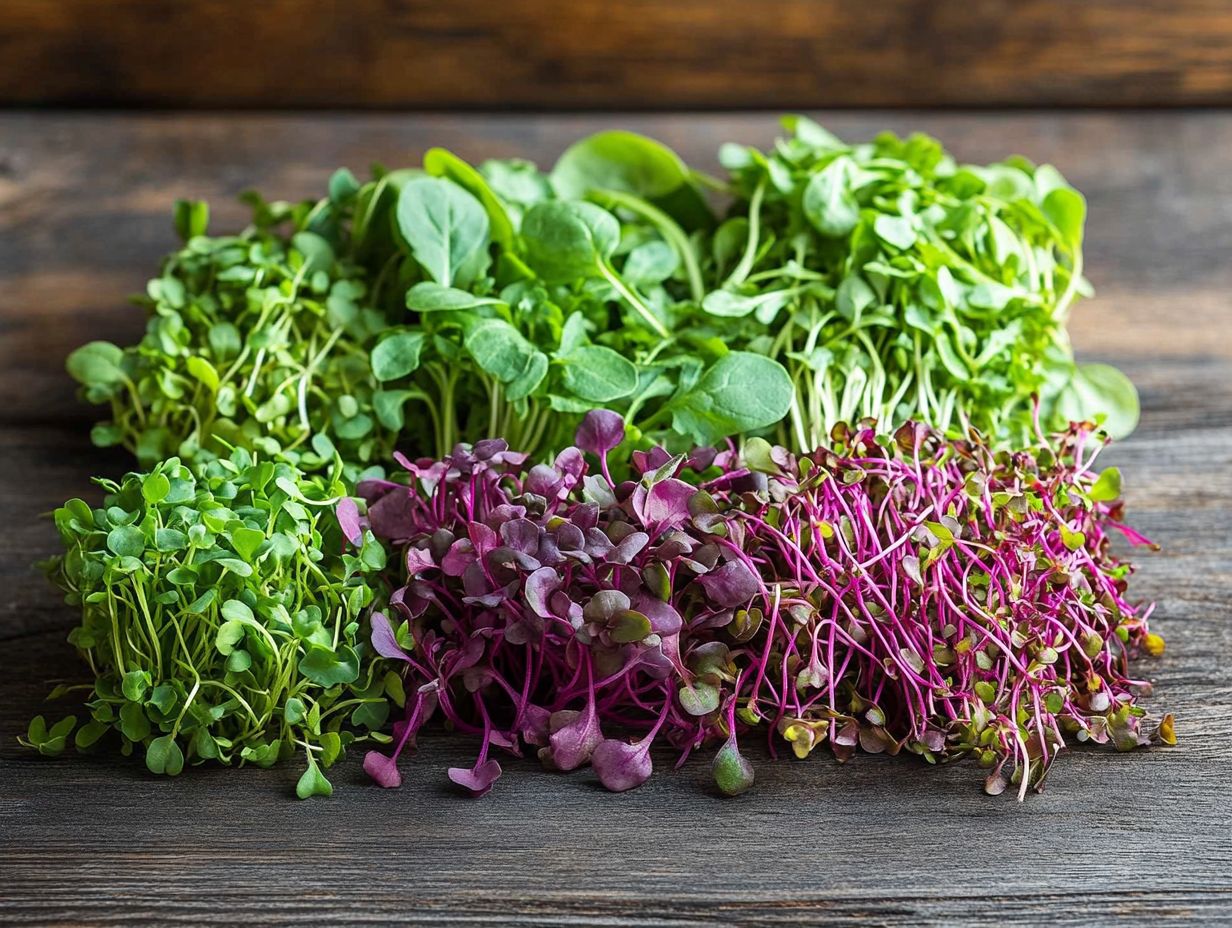
Sunflower microgreens are celebrated for their delightful nutty flavor and impressive nutritional profile. They provide a treasure trove of protein, vitamins, and essential fatty acids that contribute to your heart health and overall well-being.
These petite greens are brimming with nutrients such as vitamins A, C, and E, along with significant amounts of magnesium and folate. These nutrients play crucial roles in maintaining a healthy cardiovascular system.
Consider weaving them into your salads, sandwiches, or smoothies for a tasty and nutritious lift that complements a plant-based diet. Their versatility allows you to seamlessly incorporate them into various meals, making it easy to enjoy their health benefits while keeping your dining experience exciting and flavorful.
By adding sunflower microgreens to your meals, you can actively promote disease prevention and support a heart-healthy lifestyle. Don t miss out on the chance to boost your health with these vibrant greens!
5. Radish Microgreens
Radish microgreens are not just crunchy and flavorful; they re also brimming with antioxidants that aid in detoxification. This makes them a true powerhouse for your overall health.
These tiny greens are packed with vitamins A, C, and E, renowned for their ability to combat oxidative stress in your body. This remarkable nutritional profile supports a healthy metabolic rate and assists in flushing out harmful toxins. Additionally, 5 ways microgreens promote mental clarity further enhance their benefits for overall well-being.
Incorporating these microgreens into your daily meals is effortless. You can add them to salads for a delightful peppery kick, blend them into smoothies for an extra nutrient boost, or use them as a vibrant garnish on soups and sandwiches.
Their versatility makes them a seamless addition to any diet, elevating both flavor and health with ease.
What Are Microgreens and How Are They Different from Other Greens?
Microgreens are young vegetable seedlings that you harvest just after the first true leaves have emerged. They pack a powerful punch in terms of flavors, colors, and nutritional benefits, standing out from their more mature counterparts because they have a lot of nutrients and efficient photosynthesis. It s no wonder they ve become a favorite among health-conscious eaters.
These tiny powerhouse greens typically take only 7 to 21 days to grow, depending on the variety. You can often harvest them within just two weeks of sprouting.
Unlike sprouts, which you consume in their entirety and grow in the dark, microgreens boast distinct leaves and thrive with exposure to light. This process leads to unique flavor profiles that can range from delightfully peppery to pleasantly sweet.
Their vibrant colors not only enhance the visual appeal of your culinary creations but also provide a spectrum of antioxidants essential for your health. By incorporating microgreens into your meals, you can elevate both the taste and nutritional value, making them a fantastic addition to salads, sandwiches, and garnishes.
What Are the Nutritional Benefits of Microgreens?
Microgreens are a powerhouse of nutrients, brimming with vitamins, minerals, and antioxidants that offer a multitude of health benefits. They can play a pivotal role in cancer prevention, support heart health, and elevate your overall well-being.
Rich in essential vitamins such as A, C, E, and K, along with vital minerals like potassium and magnesium, these young plants aren’t just a pretty garnish; they’re crucial for reducing insulin resistance—a condition where the body does not respond well to insulin, making blood sugar control harder and boosting cognitive function. Additionally, incorporating 5 microgreens for enhancing eye health can provide further benefits.
Research underscores their impressive concentration of polyphenols, which combat oxidative stress and inflammation. A study published in the journal *Nutrients* reveals that microgreens can help lower blood sugar levels, making them a smart addition to a diabetic-friendly diet. Additionally, microgreens are known for their benefits in skincare, as detailed in microgreens: the secret to healthy skin.
An investigation in *Frontiers in Nutrition* highlights that the antioxidants found in microgreens bolster brain health by enhancing neural function and minimizing memory loss risks. When crafting your daily meals, incorporating top microgreen varieties for breakfast presents a compelling case for both health and flavor.
How Do Microgreens Help with Anti-Aging?
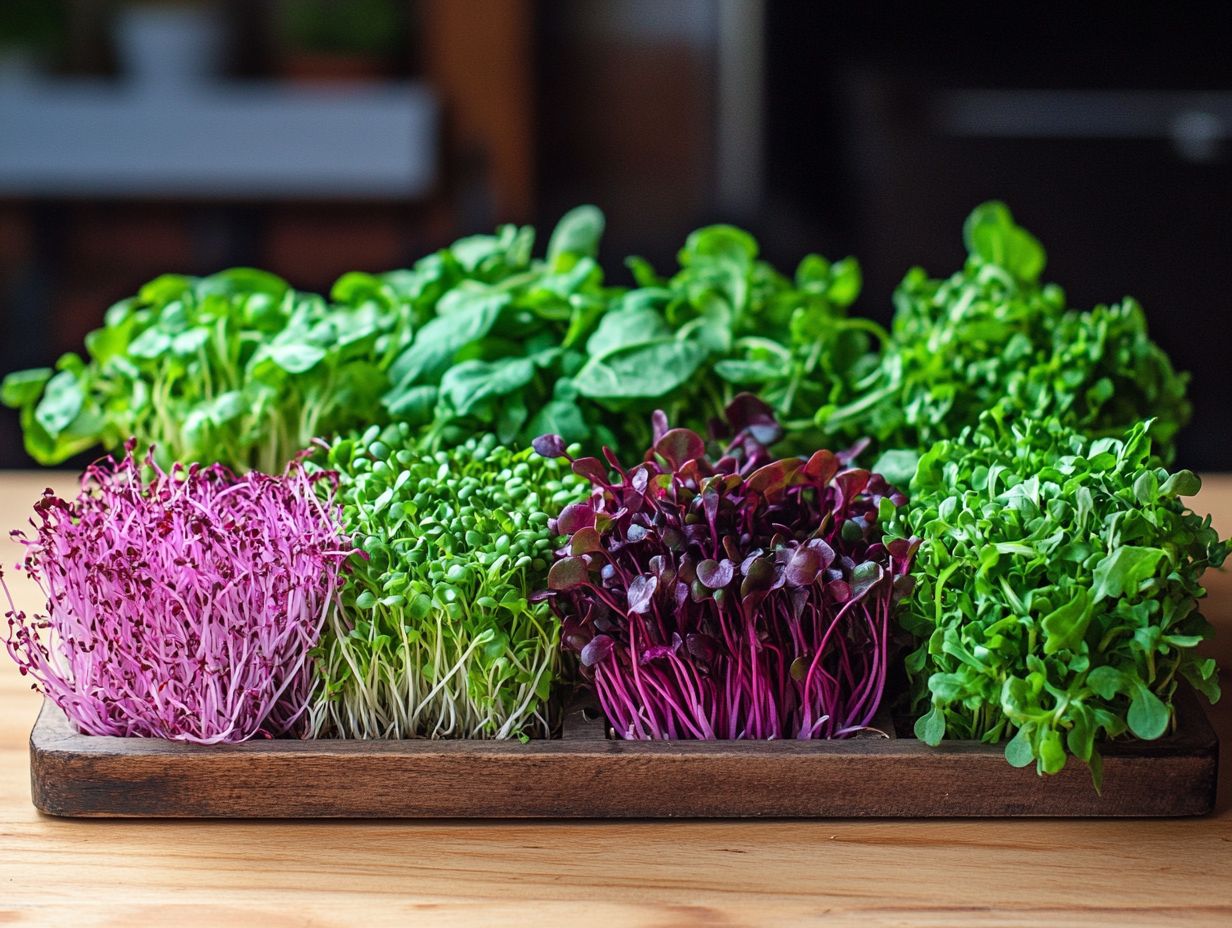
Microgreens hold a pivotal role in the realm of anti-aging, thanks to their impressive levels of antioxidants like Urolithin A and glutathione. These compounds work diligently to combat oxidative stress and promote cellular health, directly influencing the aging process.
Research reveals that these petite, vibrant plants are brimming with nutrients capable of warding off age-related ailments. For instance, a study published in the Journal of Agricultural and Food Chemistry underscores that microgreens such as kale and radish contain higher concentrations of antioxidants compared to their fully grown counterparts. Incorporating top 5 microgreens for smoothies can further enhance your nutrient intake.
These formidable antioxidants diligently scavenge free radicals, reducing inflammation and potentially counteracting the decline often associated with aging. By incorporating microgreens into your balanced diet, you not only elevate the flavor of your meals but also enhance your overall well-being. To add variety, consider exploring 5 nutritious microgreen varieties for smoothies. They become a critical element for anyone aiming for longevity and a healthier life!
How Can Microgreens Be Incorporated into a Daily Diet?
Incorporating microgreens into your daily diet is not only simple but also immensely beneficial. These tiny greens can elevate the nutritional profile of your meals while adding vibrant flavors and textures to your salads, sandwiches, and smoothies.
These little powerhouses are more than just a feast for the eyes; they’re packed with essential vitamins, minerals, and antioxidants, making them an essential addition to any dish. Consider tossing a handful of arugula microgreens into your classic Caprese salad for a delightful peppery kick! Or, blend some spicy radish microgreens into a zesty green smoothie for an instant nutrient boost. For a more adventurous palate, explore 5 unique microgreen varieties for exotic flavors to elevate your culinary creations.
Pairing these delicate greens with proteins like grilled chicken or fish can transform your weeknight dinners into something extraordinary, all while keeping them healthy and light. For a quick snack, try topping toast with avocado and sunflower microgreens; it offers a nutritious crunch that s perfect any time of day!
By experimenting with various combinations, you’ll discover that the health benefits of 5 microgreens to boost energy levels and their delightful flavors can truly elevate your everyday cooking.
What Are the Different Ways to Grow Microgreens?
Growing microgreens at home is not just rewarding; it’s remarkably straightforward. You can cultivate nutrient-rich vegetable seedlings in spaces ranging from your kitchen to your garden, effortlessly addressing those dietary gaps with fresh, home-grown produce.
With a variety of methods at your disposal such as soil-based, growing plants in water instead of soil, and aquaponic systems you can easily find an approach that fits your space and resources. Soil-based cultivation offers a traditional method that enhances both flavor and nutritional content, while growing plants in water allows for water-efficient growth, perfect for limited areas. If you’re feeling adventurous, aquaponics combines fish farming with plant cultivation, creating a symbiotic ecosystem.
When selecting seeds, opt for varieties like sunflower, radish, or kale, which are packed with nutrients. To nurture these delicate greens, make sure they’re adequately watered and receive enough light. This care will maximize their health benefits, making them a superb addition to your diet.
What Are Some Delicious Recipes Using Microgreens?
Microgreens are an incredibly versatile ingredient that can elevate both the flavor and nutrition of your dishes. Imagine vibrant salads bursting with flavor, gourmet sandwiches, and refreshing smoothies that showcase their unique health benefits!
These tiny greens are packed with flavor and essential nutrients, transforming any meal into a wholesome feast. You might toss them into a simple stir-fry for that extra crunch, blend them into homemade pesto for a delightful twist, or even mix them into your morning smoothie for a nutritious boost. For inspiration, consider exploring the top 10 microgreens for nutritional boost. The possibilities are truly endless!
By experimenting with different varieties, such as the peppery zing of arugula or the sweetness of pea shoots, you can surprise your palate and enhance your culinary creations. Embracing microgreens allows you to make healthier choices while savoring a delightful spectrum of flavors.
Frequently Asked Questions
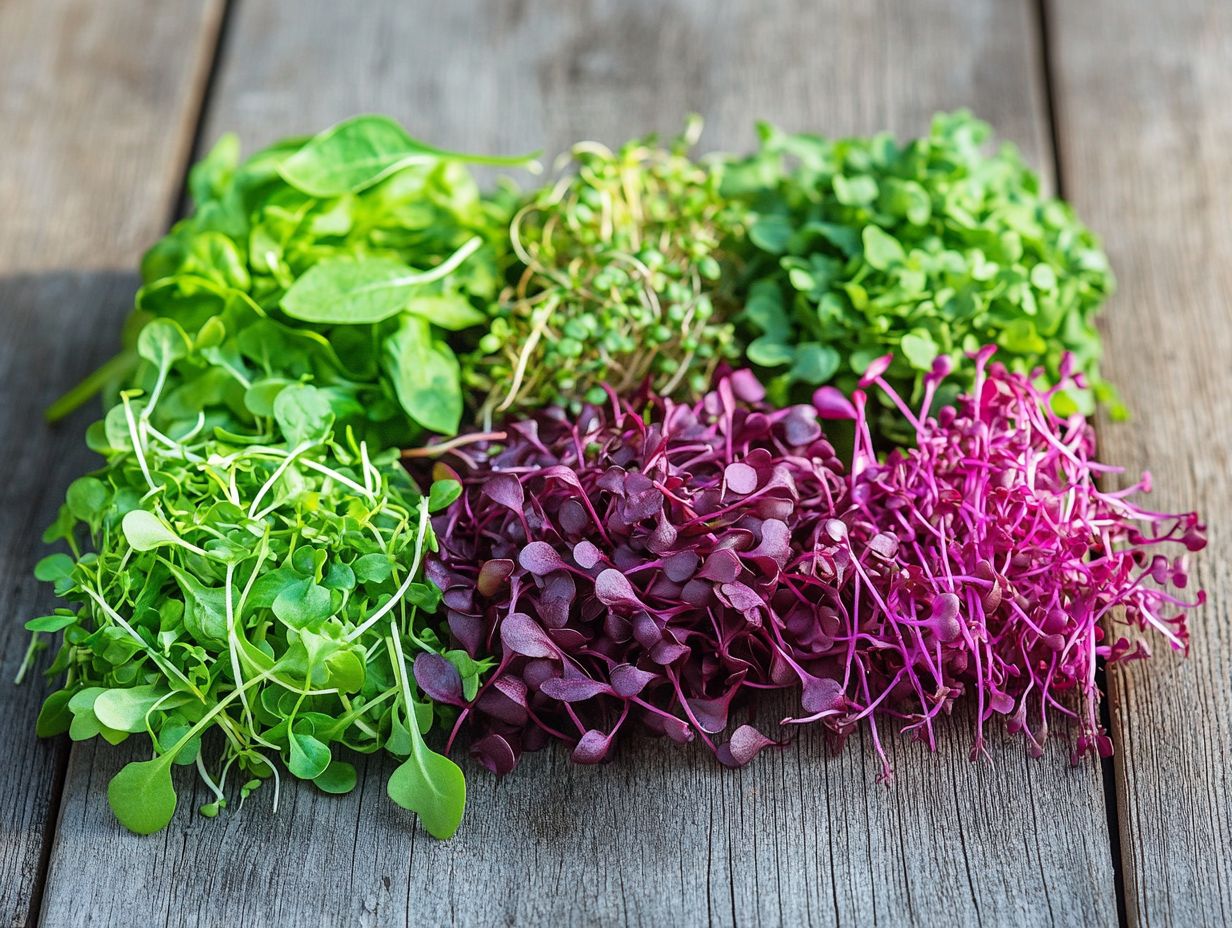
What are microgreens?
Microgreens are young vegetable greens harvested after the first leaves develop. They are smaller than baby greens and full-grown vegetables, but larger than sprouts.
What are the top 5 microgreens for anti-aging benefits?
The top five microgreens for anti-aging are broccoli, kale, red cabbage, radish, and sunflower.
Why are microgreens beneficial for anti-aging?
Dive into the world of microgreens! They re packed with vitamins, minerals, antioxidants, and natural compounds from plants that promote overall health.
How should I incorporate microgreens into my diet?
Add microgreens to salads, sandwiches, smoothies, and omelets. You can also use them as a garnish for soups or juice them for a nutrient boost.
Are microgreens safe to consume?
Yes, microgreens are safe! They are grown in controlled environments and typically washed before sale. Always wash them before consuming for extra safety.
Can anyone consume microgreens for anti-aging benefits?
Absolutely! Microgreens are a fantastic addition to a healthy diet for people of all ages. Consult a healthcare professional if you have allergies or medical conditions.


